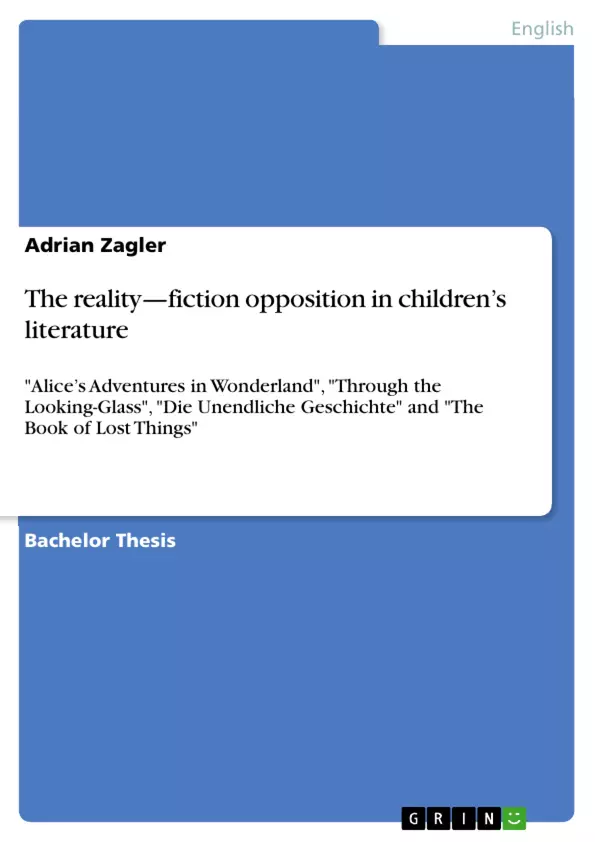Since the 1970s, scholarly interest in children’s literature has grown, and numerous studies looking into the complexity and thematic and structural depth of the texts have been published. Simultaneously, the notion of metareferentiality has sparked interest among scholars from various disciplines. Metareferentiality, though not unique to the twentieth and the twenty-first centuries, is said to be one of the key cultural phenomena of our time.
And yet, these two fields of interest, namely children’s literature and metareferentiality, have only very rarely been studied in the same context. Metareferential elements in children’s books are often seen as phenomena of dream worlds. Thus, they allow a traditional, non-critical reading in which the metareferential elements do not necessarily trigger medial awareness in the readers but can be explained logically and within the framework of the represented story worlds. Consequently, the epistemological status of reality would not be threatened by these texts.
However, as this paper aims to prove, such a reading (for instance) of the Alice-stories, Die Unendliche Geschichte and The Book of Lost Things, although undeniably possible, falls short of the true scope of the texts. As will be shown, all four books address the question of the status of fiction with reference to its opposition to reality, albeit in different ways. In their treatment of the subject, they are clearly metafictional texts with epistemological and ontological concerns that require experienced readers to fully grasp their messages. Nevertheless, they are still publicly perceived as children’s literature and are enjoyed by children and adults alike.
After some general remarks on the genre of children’s literature and on metareferentiality, this paper focuses on a particular form of metareferentiality, namely the representation and treatment of the reality—fiction opposition in the selected works, highlighting similarities and differences and describing their means and tools. This is succeeded by an analysis and comparison of these novels in several aspects of the reality—fiction opposition, i.e.: the structural depiction and framing of these two realms; how transgressions of the borders take place and which problems arise from this; how language comes into play to highlight or blur the reality—fiction opposition; and how this is connected to truth and lies, and ‘true’ identity and ‘false’ illusion, respectively.
Inhaltsverzeichnis (Table of Contents)
- INTRODUCTION
- 1 GENERAL REMARKS ON CHILDREN'S LITERATURE AND METAREFERENTIALITY
- 1.1 The elusive nature of children's literature
- 1.2 Literary metareference and the reality—fiction opposition
- 2 THE REALITY-FICTION OPPOSITION IN LEWIS CARROLL'S ALICE-STORIES
- 2.1 Introductory remarks and plot summary
- 2.2 Framing the border-crossing between reality and fiction
- 2.3 Metalepses and tangled hierarchies between reality and fiction
- 2.4 Carroll's use of language in discussing the reality—fiction opposition
- 2.5 Carroll's use of identity and illusion in discussing the reality—fiction opposition
- 2.6 Synopsis
- 3 THE REALITY-FICTION OPPOSITION IN MICHAEL ENDE'S DIE UNENDLICHE GESCHICHTE
- 3.1 Introductory remarks and plot summary
- 3.2 Framing the border-crossing between reality and fiction
- 3.3 Metalepses and tangled hierarchies between reality and fiction
- 3.4 Ende's use of language in discussing the reality-fiction opposition
- 3.5 Ende's use of language in discussing the reality—fiction opposition
- 3.6 Synopsis
- 4 THE REALITY-FICTION OPPOSITION IN JOHN CONNOLLY'S THE BOOK OF LOST THINGS
- 4.1 Introductory remarks and plot summary
- 4.2 Framing the border-crossing between reality and fiction
- 4.3 Metalepses and tangled hierarchies between reality and fiction
- 4.4 Connolly's use of language in discussing the reality—fiction opposition
- 4.5 Connolly's use of identity and illusion in discussing the reality—fiction opposition
- 4.6 Synopsis
- CONCLUSION
Zielsetzung und Themenschwerpunkte (Objectives and Key Themes)
This paper examines the representation and treatment of the reality-fiction opposition in four classic children's literature works: Alice's Adventures in Wonderland, Through the Looking-Glass, Die Unendliche Geschichte, and The Book of Lost Things. The objective is to analyze how these works utilize metafictional elements to explore the relationship between reality and fiction, particularly through the concepts of border-crossing, metalepses, language, and identity.
- The elusive nature of children's literature
- Metareferentiality and the reality-fiction opposition
- The structural depiction and framing of reality and fiction
- Transgressions of the borders between reality and fiction
- The role of language in highlighting or blurring the reality-fiction opposition
Zusammenfassung der Kapitel (Chapter Summaries)
This section summarizes the main themes and arguments of the chapters.
- Chapter 1: This chapter introduces the study by providing general remarks on the nature of children's literature and metareferentiality. It discusses the blurred boundaries between children's and adult literature and emphasizes the significance of metareferentiality in contemporary culture.
- Chapter 2: This chapter focuses on the reality-fiction opposition in Lewis Carroll's Alice-stories. It explores how Carroll frames the border-crossing between reality and fiction, analyzes metalepses and tangled hierarchies within the narrative, and examines the role of language in blurring the distinction between these two realms.
- Chapter 3: This chapter examines the reality-fiction opposition in Michael Ende's Die Unendliche Geschichte. It analyzes how Ende depicts the crossing of borders between reality and fiction, explores metalepses and hierarchical complexities, and investigates the use of language in representing these opposing concepts.
- Chapter 4: This chapter investigates the reality-fiction opposition in John Connolly's The Book of Lost Things. It examines how Connolly frames the border-crossing between reality and fiction, analyzes metalepses and hierarchical structures within the narrative, and discusses the role of language in blurring the distinction between these two realms.
Schlüsselwörter (Keywords)
The key concepts and themes explored in this work include children's literature, metareferentiality, reality-fiction opposition, border-crossing, metalepses, language, identity, and illusion. The study examines the interconnectivity of these concepts and their implications for understanding the relationship between reality and fiction in literary narratives.
- Quote paper
- Adrian Zagler (Author), 2010, The reality—fiction opposition in children’s literature, Munich, GRIN Verlag, https://www.grin.com/document/164235



